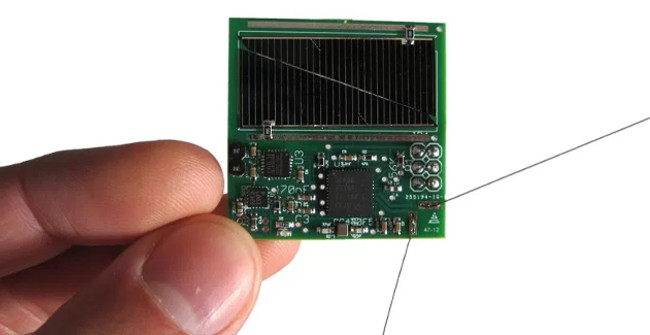The smallest satellite opens the way of interstellar travel
Successful manufacturing of ultra-small satellites is a premise for spacecraft to travel between stars.

Sprite satellite is a square circuit board weighing only 4g. (Photo: Leah Crane.)
Breakthrough Starshot project takes the first important steps when bringing the smallest satellites ever into orbit on June 23, according to New Scientist.
Breakthrough Starshot was invested 100 million USD by Russian billionaire Yuri Milner, aiming to launch ultra-small spacecraft at a rate of 20% of the speed of light to Alpha Centauri, the nearest star system is 4.37 light-years from the Sun. shining.
An Indian rocket in June carried six small satellites, called Sprite, into space. Two of them are attached to the side of larger satellites, Venta Latvian and Max Valier of Italy. After the communication system is established, the Max Valier satellite will free the remaining 4 Sprite so that they rotate in orbit.
Each Sprite satellite is a 4 g square circuit board with 3.5 cm in each side. Despite its small size, Sprite has a lot of tools such as computer processor, Solar battery, magnetometer, gyroscope, radio transceiver to contact researchers on Earth.
Until now, scientists have only received signals from one of the two Sprite satellites attached to the side of large satellites. The remaining four satellites have not been released, since the Max Valier satellite cannot contact the ground control center. The reason is that its radio antenna does not work so it cannot receive commands to release 4 satellites to carry.
Zac Manchester, head of the Breakthrough Starshot project at Harvard University, USA, thinks that a obtained signal also brings victory joy. " We really just tried to put the satellites in orbit and communicate with them. This is the first time a satellite with ultra-small size works," Manchester said.
In the near future, hundreds or thousands of Sprite satellites will be mass-produced and commissioned, to create a large network of small-sized sensors to study the atmosphere and magnetic fields around the Left. Land. Avi Loeb, the head of the advisory committee of Breakthrough Starshot project, said this could happen in the next decade.
The Breakthrough Starshot project also plans to go to another star based on StarChip, a small-sized spacecraft like the Sprite satellite attached to a light sail 1 m wide. This sail is based on the energy provided by high-powered laser light pulses emitted from the ground-based machinery. As a result, the StarChip spacecraft can accelerate to 1/5 the speed of light.
The system can reach Alpha Centauri, the closest star system to Earth, in just over 20 years. StarChips will take photos and study Alpha Centauri star as well as planets flying around it.
- The latest messages from interstellar travel objects that we observe
- Interstellar travel objects have no alien signals
- The mysterious factor for the journey to the interstellar environment
- Spacecraft can fly forever without fuel thanks to this
- America dreams of traveling to the stars
- The intense past of interstellar traveling objects visits the solar system
- Scan interstellar traveling objects suspected of alien spacecraft
- Mysterious asteroid suspects that the alien spaceship is
- When can humans set foot outside the solar system?
- Interstellar objects like cigarettes' Oumuamua is considered a comet
- The first interstellar object in the solar system 4.5 billion years
- Earth's oldest satellite in space travel
 Van Allen's belt and evidence that the Apollo 11 mission to the Moon was myth
Van Allen's belt and evidence that the Apollo 11 mission to the Moon was myth The levels of civilization in the universe (Kardashev scale)
The levels of civilization in the universe (Kardashev scale) Today Mars, the sun and the Earth are aligned
Today Mars, the sun and the Earth are aligned The Amazon owner announced a secret plan to build a space base for thousands of people
The Amazon owner announced a secret plan to build a space base for thousands of people Satellite debris poses a serious threat to the atmosphere
Satellite debris poses a serious threat to the atmosphere  What is that bright, moving star in the night sky that you see?
What is that bright, moving star in the night sky that you see?  Europe plans to launch two satellites to create total solar eclipses on demand
Europe plans to launch two satellites to create total solar eclipses on demand  Shooting down a satellite: Is it an empty threat or can it be carried out?
Shooting down a satellite: Is it an empty threat or can it be carried out?  Which country is dominating space?
Which country is dominating space?  SpaceX kicks off 2022 with the launch of 49 satellites
SpaceX kicks off 2022 with the launch of 49 satellites 